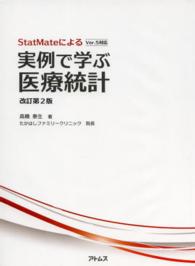- ホーム
- > 洋書
- > 英文書
- > Science / Mathematics
Full Description
Surveying Cultures uniquely employs techniques rooted in survey methodology to discover cultural patterns in social science research. Examining both classical and emerging methods that are used to survey and assess differing norms among populations, the book successfully breaks new ground in the field, introducing a theory of measurement for ethnographic studies that employs the consensus-as-culture model. The book begins with a basic overview of cross-cultural measurement of sentiments and presents innovative and sophisticated analyses of measurement issues and of homogeneity among respondents. Subsequent chapters explore topics that are at the core of successful data collection and analysis in culture studies, including:
The role of bipolar scales and Internet data collection in measuring sentiments
Key methodological variables that determine the quality of quantitative data, including measurement errors, validity, and reliability
New approaches to reliability and several new methods of assessing a respondent's degree of inculcation into group culture
Sampling, coverage, nonresponse, and measurement errors, with an in-depth discussion of their occurrence in culture surveys, their impact assessments, and how current measurement techniques are constructed to help prevent these kinds of errors
Common problems often encountered in the acquisition and communication of data, including identifying error variances, interpreting gender differences in responses, and defining the difference between cultures and subcultures
Throughout the book, each topic is accompanied by a review of related methodological literature. For many of the presented concepts, the author includes a formal analysis of the related issues in measuring cultural norms and reports on analyses. Each chapter concludes with an organized list of major findings as well as an insightful outline of specific recommendations regarding practical problems in culture studies.
Surveying Cultures serves as a valuable supplemental book to courses on survey and research methods at the upper-undergraduate and graduate levels. It is also an excellent reference for researchers in the fields of sociology, anthropology, psychology, and political science.
Contents
Preface ix
Acknowledgments xi
1 Surveying Culture 1
1.1 Case Studies of Cultural Surveys 3
1.2 Preview 18
1.3 Chapter Highlights 20
2 Measuring Sentiments 23
2.1 Dimensions of Affect 26
2.2 Bipolar Scales 35
2.3 Internet Data Collection 51
2.4 Chapter Highlights 54
3 Sentiment Repositories 57
3.1 Early Archives 58
3.2 Cross-Cultural Atlas 60
3.3 Archives Related to Social Interaction 61
3.4 U.S. 2002-2004 Project 67
3.5 Chapter Highlights 73
4 Surveys with Vignettes 75
4.1 Factorial Surveys 76
4.2 Impressions from Events 86
4.3 Attribute-Identity Amalgamations 98
4.4 Event Likelihoods 101
4.5 Synopsis 106
4.6 Chapter Highlights 108
4.7 Appendix: Impression-Formation Study Designs 109
5 Errors in Surveys 121
5.1 Coverage Errors 122
5.2 Sampling Errors 124
5.3 Nonresponse Errors 124
5.4 Measurement Errors 125
5.5 Other Errors 129
5.6 A Survey-of-Cultures Model 129
5.7 Statistics 135
5.8 Inculcation Index 139
5.9 Commonality Index 141
5.10 Variance Components 142
5.11 Implications 144
5.12 Chapter Highlights 146
6 Correlates of Enculturation 149
6.1 Indices 150
6.2 Conduct as a Rater 151
6.3 Predicting Cultural Authoritativeness 153
6.4 Implications 160
6.5 Chapter Highlights 164
7 Consensus in Sentiments 167
7.1 Component Analyses 168
7.2 Subcultures 176
7.3 Discussion 179
7.4 Chapter Highlights 180
8 Measurement Reliability 183
8.1 Reliabilities Within Stimuli 184
8.2 Reliabilities Across Stimuli 194
8.3 Chapter Highlights 200
9 Culture and Surveys 203
9.1 Unique Aspects of Sentiment Surveys 203
9.2 Frameworks for Sentiment Surveys 207
9.3 In Closing 210
9.4 Chapter Highlights 211
References 213
Index 223







